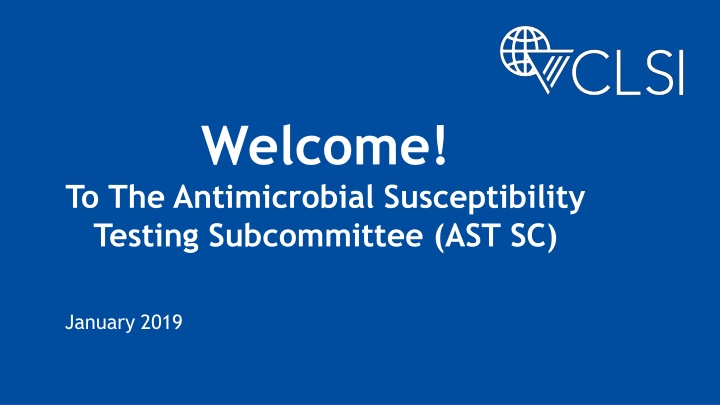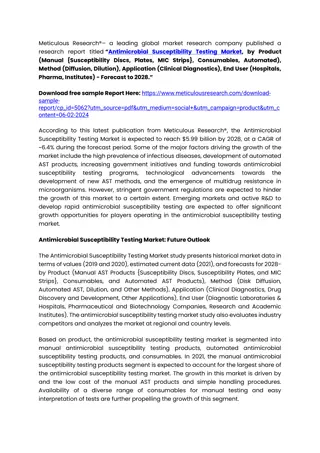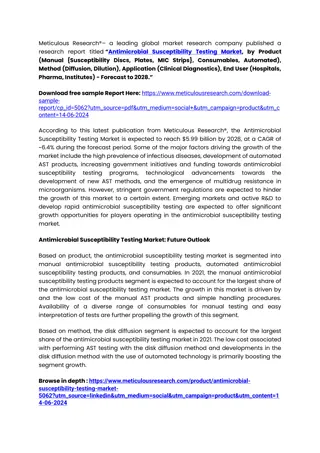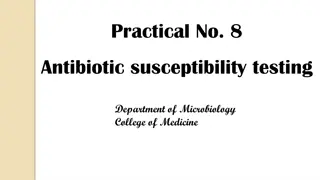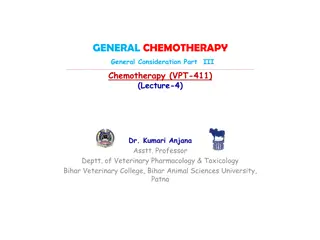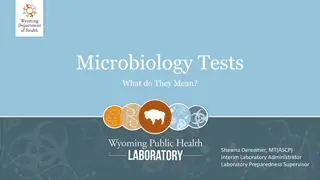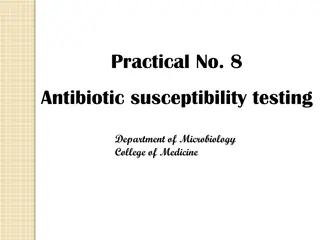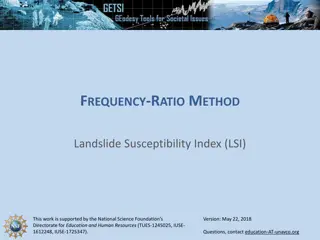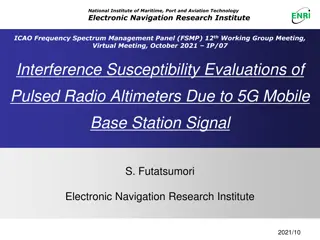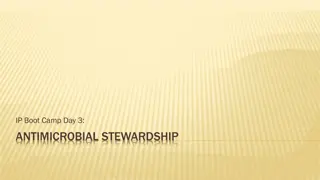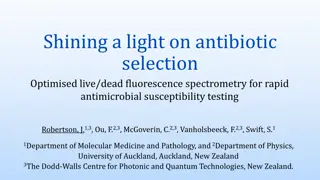Insight into Antimicrobial Susceptibility Testing Subcommittee
Review slides introducing the Antimicrobial Susceptibility Testing Subcommittee (AST.SC) in January 2019. Learn about CLSI, the AST.SC's role, CLSI's governance structure, and the history and processes of CLSI. Understand how CLSI develops consensus standards and guidelines to foster excellence in laboratory medicine.
Download Presentation

Please find below an Image/Link to download the presentation.
The content on the website is provided AS IS for your information and personal use only. It may not be sold, licensed, or shared on other websites without obtaining consent from the author.If you encounter any issues during the download, it is possible that the publisher has removed the file from their server.
You are allowed to download the files provided on this website for personal or commercial use, subject to the condition that they are used lawfully. All files are the property of their respective owners.
The content on the website is provided AS IS for your information and personal use only. It may not be sold, licensed, or shared on other websites without obtaining consent from the author.
E N D
Presentation Transcript
Welcome! To The Antimicrobial Susceptibility Testing Subcommittee (AST SC) January 2019
Introduction Please review the following slides that will give you insight into CLSI and the AST SC We will describe: How the AST SC fits into CLSI The various categories of CLSI volunteers What our AST SC does We look forward to your participation on the AST SC! When our AST SC meets How CLSI AST documents are developed
Who is CLSI? Clinical and Laboratory Standards Institute (CLSI) is a not-for-profit membership organization that brings together the global laboratory community for a common cause: fostering excellence in laboratory medicine. CLSI documents cover all areas of the clinical laboratory.
CLSI Governance Structure Eg, Microbiology Expert Panel AST Subcommittee fits here!
History of CLSI (Formerly NCCLS) 1968 the National Committee on Clinical Laboratory Standards (NCCLS) was founded when 31 clinicians and laboratory scientists from 15 organizations met to discuss ways to "improve what [laboratories] are doing for patients" and to develop a formal consensus process for standardization. 1977 - NCCLS was accredited by the American National Standards Institute (ANSI) as a voluntary consensus standards organization. Late 1970s - NCCLS became the home of the National Reference System for the Clinical Laboratory (NRSCL), a collection of reference systems intended to improve the comparability of laboratory test results. 2005 - the name NCCLS was changed to Clinical and Laboratory Standards Institute (CLSI) to encompass and embrace the international focus of this organization. CLSI has evolved into a global association of 1,400+ member organizations and 400+ individual members, as well as 2,000+ volunteers. Currently manages over 200 documents!
CLSI Process Documents are vetted through the consensus process involving the three constituencies of Professions, Industry, and Government. Meeting minutes and select additional materials are available to the public on the CLSI website. Balance Comments (both in-person at the meeting and in-writing) from users of documents are actively encouraged and addressed. Ultimate products = standards documents and other materials/programs (eg, webinars, workshops, companion products) to support the standards. Meetings are open to everyone!
Consensus Standards and Guidelines Some CLSI documents are guidelines, while others qualify as standards. Standard = identifies essential requirements for materials, methods, or practices for voluntary use in an unmodified form. Guideline = identifies requirements for materials, methods or practices, for voluntary but recommended use.
CLSI Members and Volunteers Diverse representation (worldwide) from all three constituencies. Interests between constituencies are balanced. Industry Government Professions IVD Manufacturers Pharmaceutical Manufacturers LIS / HIS Vendors Suppliers Clinical Research Organizations Public Health Agencies Regulatory Bodies Clinical Laboratories Research Laboratories Accrediting Organizations Healthcare Delivery Systems Educational Institutions Professional Societies, Trade Organizations Standards Organizations Abbreviations: IVD, In Vitro Diagnostic; LIS, laboratory information system; HIS, hospital information system.
Microbiology Subcommittees with Antimicrobial Agent Focus Antimicrobial Susceptibility Testing Subcommittee (AST SC) Bacteria (excluding mycobacteria) Separate Subcommittees: Subcommittee on Antifungal Susceptibility Tests Veterinary Antimicrobial Susceptibility Testing (VAST) Other antimicrobial subcommittees are formed as needed (eg, mycobacteria)
Introduction of Timeline of Major CLSI AST SC Documents M11 MIC Method Anaerobe M02 M07 M45 Disk Diffusion Method MIC Method Aerobe BPs Fastidious Bacteria NCCLS (CLSI) formed (1968) 1970 1975 1980 1985 1990 1995 2000 2005 2010 2015 M23 M52 M39 Guidance on BPs / QC Verification ID & AST Systems Antibiograms BPs, breakpoints; QC, quality control
AST SC Mission The mission of the AST SC is to: Develop standard reference methods for antimicrobial susceptibility tests. Provide quality control parameters for standard test methods. Establish breakpoints for the results of standard antimicrobial susceptibility tests and provide epidemiological cutoff values when breakpoints are not available. Provide suggestions for testing and reporting strategies that are clinically relevant and cost- effective. Continually refine standards and optimize detection of emerging resistance mechanisms through development of new or revised methods, breakpoints, and quality control parameters. Educate users through multimedia communication of standards and guidelines. Foster a dialogue with users of these methods and those who apply them. This mission statement is listed in the front of each AST document!
Volunteer Responsibilities: AST SC Chairholder Melvin Weinstein, MD Ensures that committee objectives are met and reports to the Consensus Council (CC) Chairholder Appoints Members and Advisors Plans, monitors, and schedules the document revision process Moderates the discussions at face-to-face meetings Does not vote (except in select situations) Vice-Chairholder James Lewis, II, PharmD, FIDSA Serves as leader in chairholder s absence Learns process in preparation for role as chairholder and when rotating from the role of chairholder, assists the new chairholder in the transition Does not vote
Volunteer Responsibilities: AST SC (Cont.) Members - appointed o Must include representatives from each of the three constituencies o Serve as authors and subject matter experts o Serve on working groups (WGs) Appointed Members and Advisors serve one-year terms that are renewable yearly for up to 4 years. o Vote on technical decisions and draft documents Advisors - appointed o Provide technical expertise to the SC o Serve on WGs o Provide input on draft documents submitted for approval
Volunteer Responsibilities: AST SC (Cont.) Reviewers o May serve on WGs and/or provide technical input o Review and comment on draft documents To become a Member, Advisor, or Reviewer and be put on the official roster, you must submit disclosure of interests and CV. In addition, you need to pay an administrative fee (this fee is usually covered through one s organizational CLSI membership). o Anyone with an interest in the AST SC s goals can become a reviewer make suggestions, submit data and join WGs. (Simply submit a request to CLSI.) Guests o Are not on the official roster o Have not submitted disclosure of interests and curriculum vitae (CV) o Can make suggestions but cannot serve on a WG
CLSI AST SC Volunteer Opportunities Function Member X X X Advisor X X X Reviewer X X X Guest Appointed by SC chair Serve on WG Contribute - raise issues X Contribute - technical expertise X X X Contribute - provide data X X X X Review / comment on draft documents X X X X Vote (preliminary in WG meeting)* Vote (final at plenary session) X X X X * If officially appointed AST SC or WG member
Documents Managed by CLSI AST SC No. Document Revision Cycle M02 Disk diffusion method (aerobes) 3 5 years M07 MIC testing methods (aerobes) 3 5 years M11 MIC testing methods (anaerobes) 3 5 years M100 Tables (disk and MIC for aerobes and MIC for anaerobes) Annual M23* Guidance for setting breakpoints, setting QC ranges, making recommendations in AST documents 5 years (or as needed) M39* Antibiograms 5 years (or as needed) M45* Fastidious organism tables 5 years (or as needed) * Guidelines
Standing Working Groups of AST SC Working Group (WG)* Primary Function Methods Development and Standardization WG Develops or modifies test methods Methods Application and Interpretation WG Determines how a test method can be used Quality Control WG Sets QC ranges Text and Tables WG Incorporates approved recommendations from other WGs into M100 Breakpoint WG Sets clinical breakpoints and epidemiological cutoff values (ECVs) Outreach WG Provides educational and informational outreach to stakeholders All WGs review data and make recommendations consistent with their primary function. * This slide excludes the ad hoc WGs.
AST SC WGs: 2019 AST Subcommittee Chairholder and Vice-chairholder WG under AST but not assigned to any of the Standing WGs 6 Standing WG and their Ad Hoc WGs M23 (revision) Methods Development & Standardization Methods Application & Interpretation Text & Tables QC Breakpoint Outreach M39 Antibiograms (revision) Coagulase Negative Staph (CoNS) M02/M07 Revision Anaerobe Cefiderocol Neisseria gonorrhoeae Cefotetan/Cefoxitin- Enterobacteriaceae mCIM Colistin AST Ceftaroline Coordinated Development Drugs-Devices Intrinsic Resistance Ceftazidime-avibactam An Ad hoc WG is under one of the 6 Standing WGs.Ad hoc WG usually has an assignment that is limited in scope and is disbanded upon completion of the assignment. Direct Blood Culture Susceptibility Daptomycin CLSI vs EUCAST Media Meropenem-vaborbactam ECVs Shigella/Fluoroquinolones
CLSI AST SC Meeting Schedule January Face to Face Meeting* January May Background Studies and More The AST SC meets twice a year. Decisions are made at these meetings. May Submit Agenda Materials June Face to Face Meeting* Much of the work is done by Standing WGs and Ad Hoc WGs between the meetings. June December Background Studies and More December Submit Agenda Materials * Receive agenda materials approximately 4 6 weeks before the meeting. You must be an AST SC or WG member or register for the meeting to receive the agenda materials.
Typical AST SC On-Site Meeting Schedule Day Session Comment Saturday Free and open to all; Continuing education credits available! Covers topics related to AST SC, antifungal SC, veterinary SC, etc. Sunday 5:00 7:00 PM Education Workshop Open to all Some concurrent (pick & choose) Solicit comments from all Preliminary vote on issues 8:00 AM 5:00 PM Working Groups 5:30 7:00 PM 6:30 7:00 PM 7:00 8:30 PM Executive session New Member Reception Reception Voting members and by invitation only Open to all new registered attendees Open to all registered attendees Monday 8:00 AM Noon Working Groups (cont d) As needed (if no WG meetings needed, plenary starts at 8 am) Open to all Solicit comments from all Final vote on issues 1:00 5:00 PM Plenary Session Tuesday 8:00 AM Noon Plenary Session (cont d)
Taking an Issue to Approval! Ad hoc Detailed discussion among those who participated in the task Working Group Standing Working Group Detailed summary of Ad hoc WGs efforts; preliminary vote AST SC Summary and final vote at plenary session
How can YOU become a WG member? Make sure you are a Reviewer (see slide 14 for more information) and determine your interest in a particular WG. Speak with the AST SC Chairholder, WG Chairholder, and/or Outreach WG member for placement in appropriate WG. Plan to attend a WG session. Feel free to make suggestions, provide data, offer to work on projects, etc.
Must YOU be a WG member to attend a WG meeting, raise issues, or contribute data? No! Anyone can raise issues/contribute data to the agenda book that is new or that is currently being discussed. Meet with WG chair (in-person at a face-to-face meeting or remotely) Material must be in the agenda book to be discussed. Deadline for submission of agenda book material is approximately 6 weeks before the January or June meetings.
To register for the meeting visit clsi.org/committeesweeks. Steps to ensure YOU will have a rewarding experience at YOUR first CLSI AST SC meeting! mhackenbrack@clsi.org For questions, contact CLSI AST SC coordinator, Marcy Hackenbrack (mhackenbrack@clsi.org). Review agenda materials that are emailed to you 4-6 weeks prior to the meeting. Decide which WGs to attend. (Some issues are ongoing; check previous meeting materials on the CLSI website to review what has been discussed at an earlier meeting.) Review CLSI M23 which describes how breakpoints and QC ranges are established. Talk with a colleague who has been volunteering with CLSI on the AST SC. Attend the free, Education Workshop on Saturday evening. Attend Sunday and Monday WGs (feel free to roam from one to another). Attend Monday and Tuesday plenary sessions.
How can you learn more about CLSI AST SC and ongoing AST SC projects? clsi.org/micro Here you will find: Minutes / Materials from previous meetings Current and past AST SC Newsletters PowerPoints from Workshop presentations Dates of upcoming meetings and much more!
Benefits of becoming a CLSI AST SC volunteer Learn about the latest developments in AST Learn about new antimicrobial agents and new resistance mechanisms Network with leaders in the AST field (microbiologists, pharmacists, clinicians, public health workers, etc.) Grow your resume with your involvement on the AST SC Obtain P.A.C.E. CE credits for free during the Education Workshop Have fun!
Thank you for your interest, dedication, and commitment!
